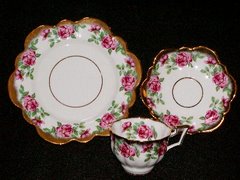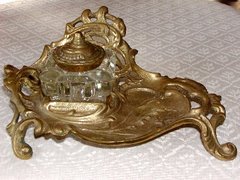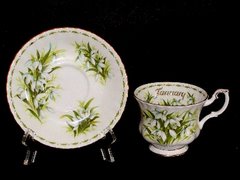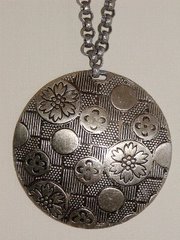
What’s only 3 inches around, beautiful to behold, and highly collectible? The answer: butter pats! These small treasures make a rich and interesting collection, yet they won’t break the bank or overwhelm your breakfront.
Butter pats were always used in the formal table settings of well-to-do Victorians as well as on the tables of royalty. Several different types of butter shapes would be used in a butter dish, from a small square of butter, to a molded elegant shape like a rosette, to a pat of butter stamped with a butter stamp that showed the family crest or other significant image.
Although butter pats were first made in the mid-1800s, they reached the height of popularity in the Victorian era between 1880 and 1910. Made by some of the most elite porcelain houses in the world, butter pats came in a wide range of shapes, colors, and patterns. Some were made as part of entire dinner sets, while others were made as sets of their own that could be coordinated with existing dinnerware. In addition, “blanks” of butter pats (as well as other types of porcelains) were available for ladies to paint on their own, a lovely and cultured pastime of the era.
After the Victorian era, dinner services and flatware sets became less complex and leaned more toward simplicity, with fewer specifically-defined objects and more pieces serving multiple purposes. Butter pats gave way to bread-and-butter dishes, which are twice the size of the butter pat. While there are still some companies that make butter pats today, the demand is a fraction of what it was a hundred years ago; though they can be made for retail sale, these pieces are more likely to be found in high-end hotels and restaurants.
With so many styles, patterns, and manufacturers to choose from, you might wonder what the most sought-after butter pats are (this, as we know from all areas of collecting, can change from time to time). Mary Dessoie (butter pat collector and founder of the Butter Pat Patter Association) writes in her informative article, “All Buttered Up For Collecting!”, butter pat aficionados are paying premium prices for butter pats no longer in use by international airlines, who would use the diminutive plates in services for first- and business-class customers. Also in demand are butter pats from diners, hotels, railroads, and steamship lines.
Butter pats were always used in the formal table settings of well-to-do Victorians as well as on the tables of royalty. Several different types of butter shapes would be used in a butter dish, from a small square of butter, to a molded elegant shape like a rosette, to a pat of butter stamped with a butter stamp that showed the family crest or other significant image.
Although butter pats were first made in the mid-1800s, they reached the height of popularity in the Victorian era between 1880 and 1910. Made by some of the most elite porcelain houses in the world, butter pats came in a wide range of shapes, colors, and patterns. Some were made as part of entire dinner sets, while others were made as sets of their own that could be coordinated with existing dinnerware. In addition, “blanks” of butter pats (as well as other types of porcelains) were available for ladies to paint on their own, a lovely and cultured pastime of the era.
After the Victorian era, dinner services and flatware sets became less complex and leaned more toward simplicity, with fewer specifically-defined objects and more pieces serving multiple purposes. Butter pats gave way to bread-and-butter dishes, which are twice the size of the butter pat. While there are still some companies that make butter pats today, the demand is a fraction of what it was a hundred years ago; though they can be made for retail sale, these pieces are more likely to be found in high-end hotels and restaurants.
With so many styles, patterns, and manufacturers to choose from, you might wonder what the most sought-after butter pats are (this, as we know from all areas of collecting, can change from time to time). Mary Dessoie (butter pat collector and founder of the Butter Pat Patter Association) writes in her informative article, “All Buttered Up For Collecting!”, butter pat aficionados are paying premium prices for butter pats no longer in use by international airlines, who would use the diminutive plates in services for first- and business-class customers. Also in demand are butter pats from diners, hotels, railroads, and steamship lines.
As collectibles, butter pats can be very affordable, with many pieces costing $10 or less. But don’t get too cozy with this price – as with any collection, most people start small and then move on to more valuable pieces. Dessoie writes that in 2003, a circa 1889-1915 Wabash railroad butter pat marked “Greenwood China, Trenton, NJ” sold at auction for $1,525, even with a chip on the piece’s face. Hand-painted portrait pats with well-dressed Victorians are also highly collectible, as are salesmen’s sample pats that were used to show prospective buyers the colors and style of a manufacturer’s china patterns.
Dessoie’s article also states that a single butter pat in the Royal Copenhagen Flora Danica pattern, considered the world’s most prestigious pattern and one of the last luxury 18th century services still being produced today, can sell for $550 with a wait time of up to one year. Another article by Dessoie, entitled “Advertising Miniatures”, gives more examples of higher prices fetched by some types of butter pats. In this article, she also informs new collectors of how to spot fakes so your collection will be authentic.
But don’t let those higher priced pats discourage you – price is not the issue with personal collections. Beautiful butter pats by Staffordshire, Spode, Limoges, Royal Doulton and many other manufacturers are easily found, as are specific patterns like Blue Willow and Geisha Girl and more general styles such as flow blue, chintz and majolica. The most interesting collections have examples of many different types of pats. The old adage holds true in all areas of collecting: Buy what you love, and you’ll never be disappointed.
Dessoie’s article also states that a single butter pat in the Royal Copenhagen Flora Danica pattern, considered the world’s most prestigious pattern and one of the last luxury 18th century services still being produced today, can sell for $550 with a wait time of up to one year. Another article by Dessoie, entitled “Advertising Miniatures”, gives more examples of higher prices fetched by some types of butter pats. In this article, she also informs new collectors of how to spot fakes so your collection will be authentic.
But don’t let those higher priced pats discourage you – price is not the issue with personal collections. Beautiful butter pats by Staffordshire, Spode, Limoges, Royal Doulton and many other manufacturers are easily found, as are specific patterns like Blue Willow and Geisha Girl and more general styles such as flow blue, chintz and majolica. The most interesting collections have examples of many different types of pats. The old adage holds true in all areas of collecting: Buy what you love, and you’ll never be disappointed.




No comments:
Post a Comment